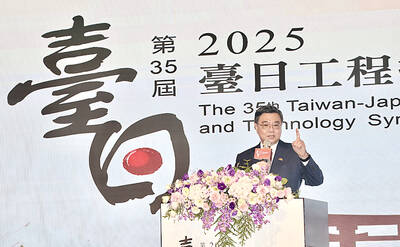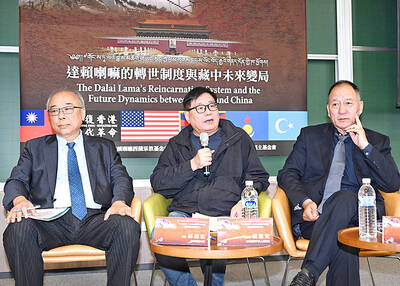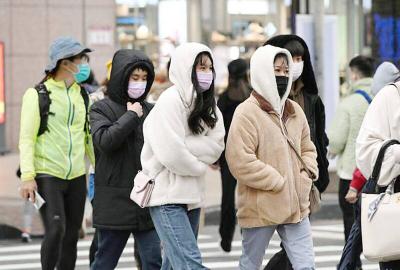President Ma Ying-jeou (馬英九) turned his back on his country by defining relations between Taiwan and China as “special relations” instead of a “state-to-state” relationship, former president Lee Teng-hui (李登輝) said last night.
Speaking with Mexican newspaper Sol de Mexico last month, Ma defined ties between Taiwan and China as “special relations,” reversing a decade-long government position.
The text of the interview was released by the Presidential Office last Wednesday. The next day, the Office elaborated on the text, saying that under the 11th Amendment to the Constitution and the Statute Governing the Relations Between the Peoples of the Taiwan Area and Mainland Area (台灣地區與大陸地區人民關係條例), the relationship between Taiwan and China is one between two regions.
“It is between the ‘Taiwan region’ and the ‘mainland region,’” Presidential Office Spokesman Wang Yu-chi (王郁琦) said on Thursday.
At a fundraising dinner last night in Taipei, Lee said that Taiwan is a de jure, independent country and that only the people, not the president, have the power to change the cross-strait “status quo” in a referendum.
“When I was president back in 1999, I at least advocated that Taiwan and China had ‘special state-to-state relations’ and that Taiwan certainly does not have an internal relationship with China,” Lee said.
“The people have elected Ma as their leader. But it does not authorize him to surrender Taiwan’s sovereignty. The decisive power lies in the hands of the people. If any changes were to take place, they would have to be through a referendum — to let the people determine their future,” he added.
Lee said Taiwan’s sovereignty is an issue for the international community. No one on either side of the Taiwan Strait could unilaterally alter the “status quo,” he said.
The Chinese Nationalist Party (KMT) and the Chinese Communist Party, he said, must not think that they can keep people in the dark by making all the decisions on Taiwan’s future.
“The US and Japan have repeatedly warned Ma of his pro-China leanings,” Lee said.
Despite reminders he had delivered to Ma that there was no “1992 consensus,” Lee said that Ma caved in to pressure and embraced the fictional deal to curry favor with Beijing so that Chinese tourists could be allowed into Taiwan.
ADDITIONAL REPORTING BY JENNY W. HSU

ALIGNED THINKING: Taiwan and Japan have a mutual interest in trade, culture and engineering, and can work together for stability, Cho Jung-tai said Taiwan and Japan are two like-minded countries willing to work together to form a “safety barrier” in the Indo-Pacific region, Premier Cho Jung-tai (卓榮泰) yesterday said at the opening ceremony of the 35th Taiwan-Japan Modern Engineering and Technology Symposium in Taipei. Taiwan and Japan are close geographically and closer emotionally, he added. Citing the overflowing of a barrier lake in the Mataian River (馬太鞍溪) in September, Cho said the submersible water level sensors given by Japan during the disaster helped Taiwan monitor the lake’s water levels more accurately. Japan also provided a lot of vaccines early in the outbreak of the COVID-19 pandemic,

Kaohsiung Mayor Chen Chi-mai (陳其邁) on Monday announced light shows and themed traffic lights to welcome fans of South Korean pop group Twice to the port city. The group is to play Kaohsiung on Saturday as part of its “This Is For” world tour. It would be the group’s first performance in Taiwan since its debut 10 years ago. The all-female group consists of five South Koreans, three Japanese and Tainan’s Chou Tzu-yu (周子瑜), the first Taiwan-born and raised member of a South Korean girl group. To promote the group’s arrival, the city has been holding a series of events, including a pop-up

TEMPORAL/SPIRITUAL: Beijing’s claim that the next Buddhist leader must come from China is a heavy-handed political maneuver that will fall flat-faced, experts said China’s requirement that the Dalai Lama’s reincarnation to be born in China and approved by Beijing has drawn criticism, with experts at a forum in Taipei yesterday saying that if Beijing were to put forth its own Dalai Lama, the person would not be recognized by the Tibetan Buddhist community. The experts made a remarks at the two-day forum hosted by the Tibet Religious Foundation of His Holiness the Dalai Lama titled: “The Snow Land Forum: Finding Common Ground on Tibet.” China says it has the right to determine the Dalai Lama’s reincarnation, as it claims sovereignty over Tibet since ancient times,

Temperatures in some parts of Taiwan are expected to fall sharply to lows of 15°C later this week as seasonal northeasterly winds strengthen, the Central Weather Administration (CWA) said today. It is to be the strongest cold wave to affect northern Taiwan this autumn, while Chiayi County in the southwest and some parts of central Taiwan are likely to also see lower temperatures due to radiational cooling, which occurs under conditions of clear skies, light winds and dry weather, the CWA said. Across Taiwan, temperatures are to fall gradually this week, dropping to 15°C to 16°C in the early hours of Wednesday